Rusholme
Rusholme is an inner-city area of Manchester, England, about two miles south of the city centre. The population of Rusholme ward at the 2011 census was 13,643.[1] Rusholme is bounded by the neighbourhoods of Chorlton-on-Medlock to the north, Victoria Park and Longsight to the east, Fallowfield to the south and Moss Side to the west. It has a large student population, with several student halls and many students renting terraced houses, and suburban houses towards the Victoria Park area.
| Rusholme | |
|---|---|
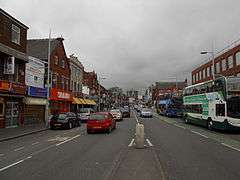 Wilmslow Road in Rusholme | |
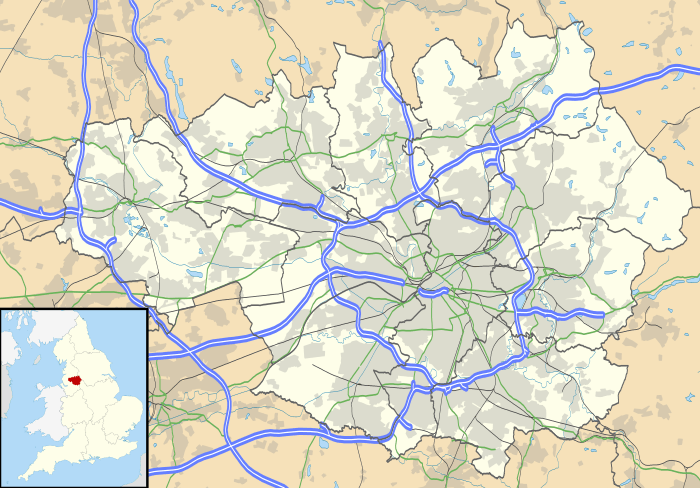 Rusholme Location within Greater Manchester | |
| Population | 13,643 (2011) |
| OS grid reference | SJ850953 |
| Metropolitan borough | |
| Metropolitan county | |
| Region | |
| Country | England |
| Sovereign state | United Kingdom |
| Post town | MANCHESTER |
| Postcode district | M14 |
| Dialling code | 0161 |
| Police | Greater Manchester |
| Fire | Greater Manchester |
| Ambulance | North West |
| UK Parliament | |
| Councillors |
|
History
Etymology
Rusholme, unlike other place names in Manchester with the suffix holme is not a true water meadow. Its name derives from ryscum the dative plural of the Old English rysc, a "rush" meaning at the rushes. The name was recorded as Russum in 1235, Ryssham in 1316 and Rysholme in 1551.[2]
Early history
Late in the Roman occupation of Britain a hoard of about 200 gold coins was hidden in the valley of the Gore Brook. These date from the 2nd and 3rd centuries AD and were found where Birchfields Road crosses the brook in the 1890s. They are now held in the Manchester Museum.[3]
The name Rusholme first appears in the mid-13th century, when "Russum" is mentioned. A house is known to have existed at Platt at that time, which was replaced by a larger one of black-and-white construction. This remained the home of the Platts until the present classical building replaced it in the mid-18th century. An early record of the Platt estate mentions the Nico Ditch, an 8th or 9th-century Anglo-Saxon linear earthwork running east–west through the area and probably marking an administrative boundary.[4] Tales of battles between Danes and Normans associated with the road names Danes Road and Norman Road are not accepted by historians. Another black-and-white hall at Birch was probably built in the 16th century.[3]
The economy of the area was dependent on agriculture until the 18th century; however during the 17th and 18th centuries there was a growth of cottage industries such as spinning, weaving and brickmaking.[5]
Social history
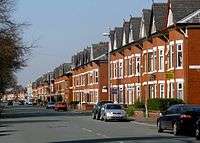
Over the Victorian era, there were several different socio-political meanings of Rusholme. Primarily, it was a township based around a general area known as Rusholme since at least the 13th century. The area grew into a township, and by the beginning of the 19th century, it had its own government responsible for public health, roads, policing, poor relief, and other local government tasks. Rusholme was originally a politically autonomous entity, which was vital to its self-conception as a discrete area even after its incorporation into Manchester. Low-cost terraced housing built between 1880 and 1930 dominates the landscape, along with a sprawling council housing estate from the interwar period.
Political history
Richard Cobden, William Royle (author of a history of the township), and Thomas Lowe (1815–1892) were long-time residents. Lowe began working as a baker and became a flour dealer, later a nurseryman and finally the proprietor of a dairy.[6][7] Prime Minister H. H. Asquith was married here in 1877 to Miss Helen Melland.[8]
The Conservative Dame Kathleen Ollerenshaw was for 26 years one of the councillors for Rusholme on Manchester City Council, before becoming Lord Mayor of Manchester in 1975–1976. Other local politicians included ward Councillor Paul Shannon, a Liberal Democrat and former deputy leader of the Manchester City Council Liberal Democrat group who was defeated by Ahmed Ali (Labour) in May 2012. Rabnawaz Akbar was elected as a Labour councillor for Rusholme ward in May 2010. Councillor Akbar served on the Citizenship and Inclusion Committee.
Governance
_2018.png)
Rusholme was a separate town until it was incorporated into Manchester in 1885. It is served in Westminster by the MP for Manchester Gorton, currently Afzal Khan.[9]
- Councillors
Rusholme is represented on Manchester City Council by three Labour councillors, Ahmed Ali,[10] Jill Lovecy[11] and Rabnawaz Akbar.[12]
| Election | Councillor | Councillor | Councillor | |||
|---|---|---|---|---|---|---|
| 2004 | Lynne Williams (Lib Dem) | Abu Chowdhury (Lib Dem) | Paul Shannon (Lib Dem) | |||
| 2006 | Lynne Williams (Lib Dem) | Abu Chowdhury (Lib Dem) | Paul Shannon (Lib Dem) | |||
| 2007 | Lynne Williams (Lib Dem) | Abu Chowdhury (Lib Dem) | Paul Shannon (Lib Dem) | |||
| 2008 | Lynne Williams (Lib Dem) | Abu Chowdhury (Lib Dem) | Paul Shannon (Lib Dem) | |||
| 2010 | Rabnawaz Akbar (Lab) | Abu Chowdhury (Lib Dem) | Paul Shannon (Lib Dem) | |||
| 2011 | Rabnawaz Akbar (Lab) | Kate Chappell (Lab) | Paul Shannon (Lib Dem) | |||
| 2012 | Rabnawaz Akbar (Lab) | Kate Chappell (Lab) | Ahmed Ali (Lab) | |||
| 2014 | Rabnawaz Akbar (Lab) | Kate Chappell (Lab) | Ahmed Ali (Lab) | |||
| 2015 | Rabnawaz Akbar (Lab) | Kate Chappell (Lab) | Ahmed Ali (Lab) | |||
| 2016 | Rabnawaz Akbar (Lab) | Kate Chappell (Lab) | Ahmed Ali (Lab) | |||
| By-election 4 May 2017 |
Rabnawaz Akbar (Lab) | Jill Lovecy (Lab)[13][14] | Ahmed Ali (Lab) | |||
| 2018 | Ahmed Ali (Lab) | Jill Lovecy (Lab) | Rabnawaz Akbar (Lab) | |||
| 2019 | Ahmed Ali (Lab) | Jill Lovecy (Lab) | Rabnawaz Akbar (Lab) | |||
indicates seat up for re-election. indicates seat won in by-election.
Geography
The community is surrounded by Fallowfield to the south, Moss Side to the west, Victoria Park to the east and Chorlton-on-Medlock to the north.
Platt Fields Park
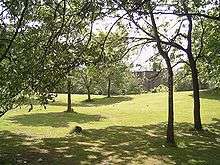
A large public park in the south-west, it opened in 1910 and proved popular; it was maintained by a team of up to 50 gardeners until the second half of the 20th century. The centrepiece is a large pleasure lake used for boating and fishing. The grounds contain Platt Hall, several formal gardens, and three dedicated show fields for outdoor events. In 2010, Platt Fields Park received a Green Flag Award for achieving the national standard for parks and green spaces.
Churches
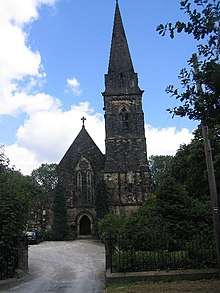
The Anglican Church of the Holy Trinity is in Platt Lane. At Birch in Rusholme is the now disused, much older chapel of ease of St James (formerly known as Birch Chapel). The present building was built in 1845–1846 to replace an earlier chapel of 1595. The architect was J. M. Derick and it is in Gothic revival style. The south-west tower is topped by a broach spire; the aisle arcades have five bays.[15] Since its conversion into a nursing home it has been known as St James House. The Housing Group of the St James', Birch, Fellowship investigated housing conditions in Chorlton-on-Medlock in 1931.[16]
In Thurloe Street is the Roman Catholic Church of St Edward. The architect was E. W. Pugin and the church was built in 1861–1862. It is small and the exterior sober; the planned south-west tower was never built and there is an apse at the east end. The arcades have short polished granite columns.[15]
A Wesleyan Church once stood on Dickenson Road near the junction with Wilmslow Road. It was designed in the Gothic Revival style by the architects William Hayley & Son, and opened in 1862. The chapel closed to worship in 1937 and after some years in use as a film and television studio, it was demolished in 1975.[17][18]
Culture and cultural references
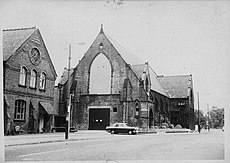
John Ruskin gave the lectures later published as Sesame and Lilies in 1865 at Rusholme Town Hall.
In 1947 the disused Wesleyan church on Dickenson Road was converted into a film studios by Mancunian Films. Between 1947 and 1954 the company produced many feature films here, including the first Manchester-made feature film, Cup-Tie Honeymoon starring Sandy Powell and Pat Phoenix. Many Mancunian productions were filmed in local streets.[19] In 1963 the BBC bought the studios as its northern base and on New Year's Day 1964, the first edition of Top of the Pops was broadcast from the Rusholme premises, presented by Jimmy Savile and opening with The Rolling Stones performing "I Wanna Be Your Man". Top of the Pops was broadcast from Rusholme until 1967, when the show moved to a larger facility at Lime Grove Studios in London.[20] In 1975 the BBC transferred its operations to the New Broadcasting House on Oxford Road and the Dickenson Road chapel building was demolished. Today, a commemorative plaque affixed to a house marks the site of the former studios.[21]
Rusholme was mentioned in the song "Rusholme Ruffians" by the Smiths on their 1985 album Meat Is Murder. According to the Smiths' singer, Morrissey: "[The song] is about going to a fair and being stabbed.[22]
Mint Royale's 1999 album On the Ropes contained a track titled "From Rusholme with Love".
Rusholme was the home of the second indoor ice skating rink in England, after the London Glaciarium, although this has since been replaced by a grocery store, having spent many years as a cabaret venue (Oceans 11).
Social and economic conditions
Social conditions
Rusholme is one of the areas in south Manchester, along with Moss Side, Longsight, Hulme and Old Trafford, to have suffered a problem with gang-related gun crime and gang activity. However, shooting incidents have declined in recent years.[23]
Wilmslow Road
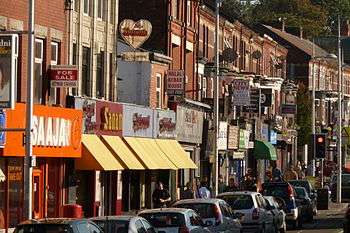
Wilmslow Road is part of the B5117, a thoroughfare running from Parrs Wood north into the city centre, traversing the campuses of the University of Manchester and Manchester Metropolitan University. It forms part of what is the busiest bus route in Europe,[24] with many stops being serviced by a bus from one of many different bus companies every 60 to 90 seconds during peak times. A section of this road known locally as the Curry Mile contains at least 70 restaurants, takeaways and kebab houses specialising in the cuisines of South Asia and the Middle East. Apart from fashion, grocery and music shops, this section of the road had several traditional English pubs including Hardy's Well (currently closed, January 2016), the Whitworth (now a coffee shop, January 2016), and the Huntsman Inn (currently closed, January 2016). Appleby Lodge is a 1930s block of flats opposite Platt Fields Park.
Notable people
The cricket writer and music critic Neville Cardus (1888–1975) was born in Rusholme, as were musician Roy Harper (born 1941), actors Alan Badel (1923–1982) and Tina O'Brien (born 1983), and the novelist and dramatist Ian Hay: John Hay Beith (1876–1952). Others include Marguerite Addy, a Spanish Civil War nurse and Second World War spy.
See also
References
Footnotes
- "City of Manchester ward population 2011". Retrieved 5 January 2016.
- Mills 1976, p. 129
- Sussex (1984); p. 3.
- Nevell, Mike (1998), Lands and Lordships in Tameside, Tameside Metropolitan Borough Council with the University of Manchester Archaeological Unit, pp. 40–41, ISBN 1-871324-18-1
- Sussex (1984); pp. 3–4.
- Edward Strutt (1892), Memorials of Mr. Thomas Lowe, of Rusholme.
- "Genealogy Data Page 164". Maris Ancestry. Retrieved 25 July 2010.
- Sussex (1984); p. 14.
- "Afzal Khan MP". parliament.uk. UK Parliament. Retrieved 24 May 2018.
- "Ahmed Ali". manchester.gov.uk. Manchester City Council. Retrieved 24 May 2018.
- "Jill Lovecy". manchester.gov.uk. Manchester City Council. Retrieved 24 May 2018.
- "Rabnawaz Akbar". manchester.gov.uk. Manchester City Council. Retrieved 24 May 2018.
- Staff writer (20 March 2017). "Former Environment Exec Kate Chappell steps down from Council". Manchester Climate Monthly. Retrieved 5 May 2017 – via WordPress.
- "Elections result 4th May 2017". manchester.gov.uk. Manchester City Council. 4 May 2017. Retrieved 5 May 2017.
- N. Pevsner (1969) Lancashire; 1. Harmondsworth: Penguin; p. 321.
- Some Housing Conditions in Chorlton-on-Medlock, Manchester. Manchester and Salford Better Housing Council, 1931.
- "Wesleyan Chapel: Dickinson Road Rusholme - Building | Architects of Greater Manchester". manchestervictorianarchitects.org.uk. Retrieved 26 July 2020.
- "Genuki: Dickenson Rd Wesleyan Methodist, Rusholme, Lancashire". www.genuki.org.uk. Retrieved 26 July 2020.
- Lee, CP (20 January 2012). "Mancunian Film Company History". It's a Hot 'Un. Archived from the original on 20 January 2012. Retrieved 25 July 2020.
- "Top of the Pops - BBC Studios (Rusholme)". www.manchesterbeat.com. Retrieved 25 July 2020.
- Plaques, Open. "Wesleyan Church, Rusholme green plaque". openplaques.org. Retrieved 26 July 2020.
- The Old Grey Whistle Test, 1985.
- BBC, No author stated (4 June 2008). "Funding boost for crime unit". BBC News. BBC. Retrieved 29 April 2009.
- O'Rourke, Aidan (26 October 2006). "Oxford Rd Manchester with Stagecoach bus". EyeOnManchester. Archived from the original on 28 September 2007. Retrieved 3 September 2007.
Bibliography
- Anderson, Bruce (2012). "Rusholme & Victoria Park Archive". Dale Street, Manchester: author. Retrieved 19 February 2012.
- Mills, David (1976), The Placenames of Lancashire, Batsford, ISBN 0-7134-5236-6
Further reading
- Jill Cronin and Frank Rhodes, Rusholme and Victoria Park. Stroud: Tempus, 2006 ISBN 0-7524-4198-1
- William Royle, Rusholme Past and Present, being a gossipy talk of men and things. Manchester: Wm. Hough & Sons, 1905
- William Royle, History of Rusholme, with a gossipy talk of men and things. Manchester: Printed at the W. Morris Press, 1914
- D. K. Royle, William Royle of Rusholme. Manchester: Sherratt & Hughes, 1924
- Gay Sussex and Peter Helm, Looking Back at Rusholme & Fallowfield. Altrincham: Willow, 1984